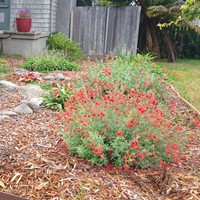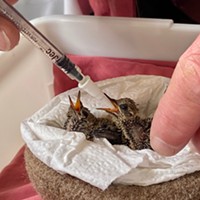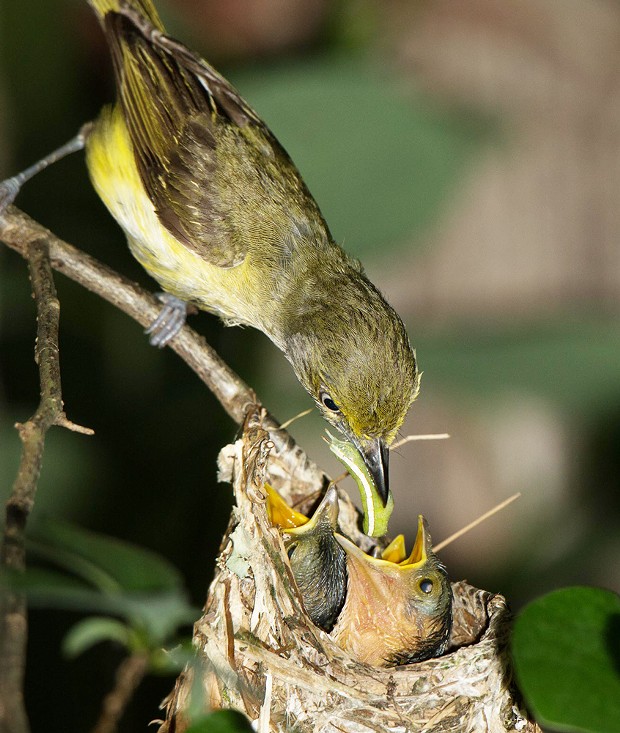[
{
"name": "Top Stories Video Pair",
"insertPoint": "7",
"component": "17087298",
"parentWrapperClass": "fdn-ads-inline-content-block",
"requiredCountToDisplay": "1"
}
]
Here's some good news for gardeners who are concerned about the environment: We can make an important, positive impact by the plant choices we make in our gardens.
How do you choose plants? I remember that when I started gardening, I wanted flowers, flowers and more flowers, lots of color and fragrance. I think for many of us our plant choices were primarily based on aesthetics and functionality. We chose plants that could provide screening and privacy and curb appeal. We often wanted plants that were familiar to us, as well as the newest garden varieties.
Then we started hearing about bird populations declining, about colony collapse disorder in honeybees, about monarch butterflies in trouble. And so, we began to add plants to our gardens that could support the birds and the bees and the butterflies.
In addition to planting for pollinators, we need to plant for caterpillars. This is the message of Douglas Tallamy, a professor of entomology and wildlife ecology at the University of Delaware, who has pioneered research into the importance of native plants to our plummeting insect and bird populations. He has written several books (three are available at the library) and he has a number of videos available on YouTube. According to him, caterpillars are crucial to healthy ecosystem food webs because they transfer more energy from plants to other animals than any other type of plant eater. As he remarks in an article in the Dec. 2022 issue of Fine Gardening, "You can look at the health of an ecosystem by knowing how healthy your caterpillar populations are."
Furthermore, 96 percent of terrestrial birds in this country raise their young on insects, and caterpillars are considered the optimum food for baby birds. Compared to other insects, caterpillars are large and soft, which makes them easy for nestlings to digest.
If insects, including caterpillars, are vital components of the food web, the next question is what plants are best at supporting them. Tallamy's research clearly demonstrates that the plants that are most useful are native plants. A small percentage of leaf-eating insects are generalists that can eat a wide variety of plants. But the vast majority of leaf-eating insects are specialists in terms of which plants they can eat, often restricted to just one plant genus or family. Plants produce chemical and physical defenses to avoid being eaten; specialist insects must have co-evolved with a particular plant lineage for thousands of years in order to overcome these defenses. And that's why native plants host more insects than non-natives. A good example of this is the monarch butterfly, which has a long evolutionary history with milkweeds that has enabled monarch caterpillars to eat the plant without being poisoned by its toxic chemicals.
Non-native plants are not evil in themselves (though non-native invasive plants should definitely be avoided). Non-natives are simply plants that have not been here long enough to evolve a relationship with insects that can live on them. This is true even for plants like ginkgo trees that have been grown in the U.S. for 400 years. Non-native plants are problematic because they support little insect activity and therefore have a negative ripple effect throughout food webs.
We need to grow native plants but not just any native plants. One of the most significant results of Tallamy's research is the "keystone plant" concept — the discovery that some native plants have much more impact than others in terms of supporting caterpillars. He emphasizes, "You can have a landscape comprised of 100 percent native plants and still support little because you've chosen natives that don't make a lot of food." His research has revealed that, across the country, only 5 percent of native plant genera (plural of genus) support 75 percent of caterpillars, and just 14 percent of native plant genera support 90 percent of caterpillars. These plants, primarily trees and shrubs, are what Tallamy calls "keystone" plants.
If you're wondering what your local keystone plants are, visit the National Wildlife Federation website at nwf.org/NativePlantFinder/. Set your location by entering your zip code, and you will see trees, shrubs, flowers and grasses native to your area ranked by the number of butterfly and moth species that use them as host plants for their caterpillars.
For Eureka (95501), the top 10 native plants are: willows (which support 328 species of caterpillars); oaks (275); bitter cherry/choke cherry (262); aspen/cottonwood/poplar (230); beach pine (220 species); red alder/white alder (202); Oregon crabapple (155); bigleaf maple/vine maple/mountain maple (120); ceanothus (120); and grand fir/white fir (117). (Note that these numbers apply only to native plant species. Japanese maples, for instance, most likely support roughly half the number of caterpillars species listed.)
Tallamy is not suggesting people plant only native plants, but he is urging us to focus on planting keystone trees and shrubs. If we gardeners follow this advice, we can still retain many smaller, non-native flowering plants in our gardens. And if you're asking, "Why would I want caterpillars on my plants?" Tallamy points out that birds eat most of the caterpillars before they get very large, usually before they damage the foliage to any noticeable extent. Growing these keystone plants gives us the opportunity to actively promote the survival of birds, bees, butterflies and other insects so crucial for the health of our planet.
Donna Wildearth (she/her) is passionate about plants and is a retired teacher and landscape designer.
Speaking of...
-

Equinoctial To-Do and Native Plants
Sep 21, 2023 -

A Bird in Hand
Aug 17, 2023 -

Jump-Starting Electric Car Batteries: Will Supply Problems Stall California’s Mandate?
Mar 1, 2023 - More »
































